Why is fintech so fascinating? Without a banking or trading background, I am fascinated by the fact that most of the startups I see in this space are working on something hard, different and potentially massive. So what is great about fintech?
First, fintech is hard. Fintech requires more than sourcing and selling. Smart SEM or customer acquisition tactics. It usually requires deep integration into the technology of partners, that often use legacy systems. And 600 page manuals. Nope, not everyone has a sexy REST Api in this world. Digging through these manuals, negotiation for adaptions to better ingrate ones service and convincing the slow moving world to allow to draw data or push some is time consuming, requires special skills and can be frustrating. And mastering difficult things is always rewarding. The results are difficult to copy and give a certain form of gratification that feels like beating a system, rather than only overcoming a difficult hurdle.
Second, fintech startups often work as enablers or as a platform for people. Or at least have an impact cross vertical, not only for a single case. They enable other companies to exist, scale or internationalize. Fintech startups enable people to pay easier, invest smarter, save time and resources that can be used otherwise. They often make your life better, rather than just serving a specific need.
Third, most startups I see have a good possibility to become unicorns or at least scale massively with little resources. And I don’t mean the upfront cost in tech. Which can be big. The leverage is unbeatable. Small teams can have a dramatic impact. If successful. Investors call this unlimited upside potential. There are enough examples which succeeded, or are on a good path getting there. And this is fascinating both for an investor and for someone who is interested in the business part of the newspaper in general.
And finally, the innovation we are going to see in the financial technology space in the next years is going to overcome borders, disrupt historicly existing systems, make ourselves wonder why things were socially accepted the way they were and ease our lives fundamentally. The best is yet to come.

Seed Round & Series A Cap Table Template
There are many different ways of displaying a cap table.
We have found it to be the easiest to display each round of increasing stock on the x-axis. This way the development for each participating party is visible easily.
I want to share my latest template (heavily influenced by @MaxClaussen) which I use to show the results of our financing on the distribution of shares when I negotiate valuation, ESOP and investment amount. I just recently used this way of displaying equity distribution for a Series A and a Seed deal.
Feel free to use either the Excel or the Google doc version. Add more financing rounds to the right if needed. Turn ESOP increase before or after the financing to 0 if you don’t plan to increase the option pool.
Try out the google doc version of the Series A Cap Table Template
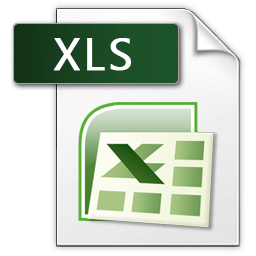 Excel Series A Cap Table Template (pay with a tweet)
Excel Series A Cap Table Template (pay with a tweet)
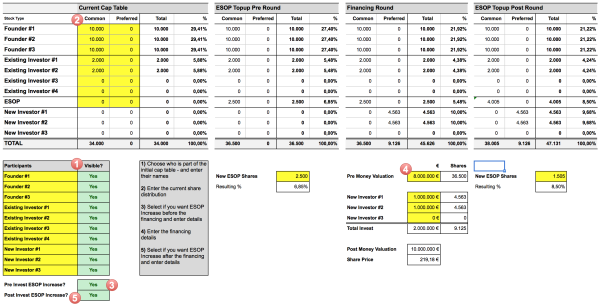
Please note, the Excel Version includes some VBA code that adds or removes the ESOP rounds and updates equity distribution based on your settings.
For later stage financing, you will need to add more stock classes, and more financing rounds. I will provide an updated version which includes convertible notes soon.
We have found it to be the easiest to display each round of increasing stock on the x-axis. This way the development for each participating party is visible easily.
I want to share my latest template (heavily influenced by @MaxClaussen) which I use to show the results of our financing on the distribution of shares when I negotiate valuation, ESOP and investment amount. I just recently used this way of displaying equity distribution for a Series A and a Seed deal.
Feel free to use either the Excel or the Google doc version. Add more financing rounds to the right if needed. Turn ESOP increase before or after the financing to 0 if you don’t plan to increase the option pool.

Please note, the Excel Version includes some VBA code that adds or removes the ESOP rounds and updates equity distribution based on your settings.
For later stage financing, you will need to add more stock classes, and more financing rounds. I will provide an updated version which includes convertible notes soon.
Industry Standards of B2B Marketing KPIs
I received many questions after I released the Marketing KPI Tracking Dashboard two weeks ago that sounded like this: What are good valued for the KPIs that I track? I was reluctant to concrete answers as I feel that might lead some people in the wrong direction.
So most of the times my my answer was: It depends. It depends on your business model, stage, industry, geography, competition. It also depends on what you or your investor are happy with. In short: One can not tell in general.
Yet, the great guys from Insight Partners tried to do just that in a very creative way:
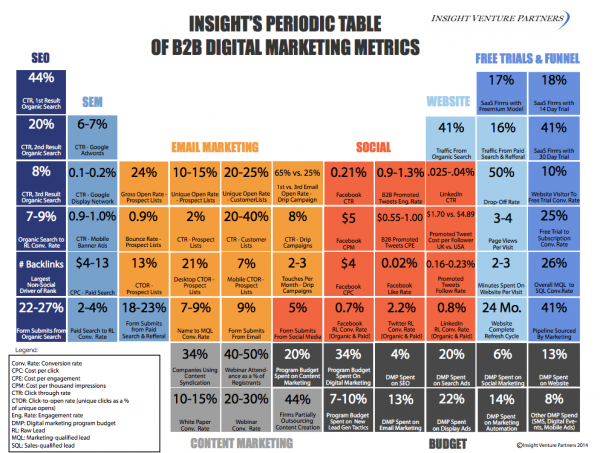
Though I disagree with giving general KPI goals without knowing what one is actually doing, this might give some people (note: in the B2B world) figures to orient themselves on. I however believe this to be a little dangerous, because what works for some might not work for you. It also makes you feel content too easy when you reach a KPI someone else gave you, while there might be leeway to improve. Nevertheless, it is great to use when you feel you are off track too much.
So most of the times my my answer was: It depends. It depends on your business model, stage, industry, geography, competition. It also depends on what you or your investor are happy with. In short: One can not tell in general.
Yet, the great guys from Insight Partners tried to do just that in a very creative way:

Though I disagree with giving general KPI goals without knowing what one is actually doing, this might give some people (note: in the B2B world) figures to orient themselves on. I however believe this to be a little dangerous, because what works for some might not work for you. It also makes you feel content too easy when you reach a KPI someone else gave you, while there might be leeway to improve. Nevertheless, it is great to use when you feel you are off track too much.
Marketing KPI Tracking – An E-Commerce Example Dashboard
Many early stage entrepreneurs don’t 1) measure their KPIs constantly, 2) track them systematically and finally, 3) interpret the data and draw the right conclusions from it.
And there are easy and understandable explanations for that. It’s time consuming, it’s cumbersome, and often you don’t know where to start. Yet, almost everyone agrees that it is necessary to draw the right conclusions and to steer your marketing ship into the right direction.
Here is an initial Marketing KPI Tracking tool to compare your marketing channels – modeled for an e-commerce business. You can, actually you should, adapt it to your needs, business model, and status of your company. However, you should start tracking your activities as early as possible.
Try out the google doc spreadsheet here.
 Download XLS Version in exchange for a Tweet / Like here.
Download XLS Version in exchange for a Tweet / Like here.
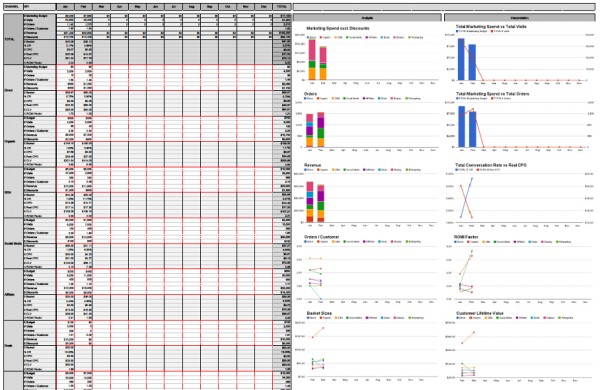
The dashboard is setup in google docs, you can also download it and use it in excel. Yet, I strongly suggest that all influencing team members have a clear view on your companies KPIs at all time. I therefore recommend using a google doc version. As a matter of fact, I recommend making people responsible to add the data for their work streams / marketing channels themselves. This way you make sure everyone is always up to date with the relevant key performance indicators that he/she is responsible for. Nevertheless, these KPIs are sensitive data. Make sure to withdraw access if your employees move on or leave your company. ** UPDATE ** As Marc from Jakarta just told me, the Excel download does not seem to work right now. I will be publishing a dedicated offline version soon. ** UPDATE **
The sheet tracks the following KPIs, broken down per channel and over time:
One could argue, that optimizing for profit margin and comparing channels on a contribution margin basis would solve this issue. However, the counter argument begins with: It depends. It depends on what your goal is. If your only goal is to raise the bottom line, comparing channels by a profit margin / contribution margin view is ultimately correct. In my opinion. Yet, can you scale the most profitable channel indefinitely? How much time do you spend on these most profitable channels? Furthermore, many companies, especially in the early stage, look for more than just margins. They want to to grow. Grow in orders / customers / basket sizes to then show improvements to raise the next round of money. Therefore it seems logical to track and compare more than just the bottom line. However, this discussion will be subject for a post of its own.
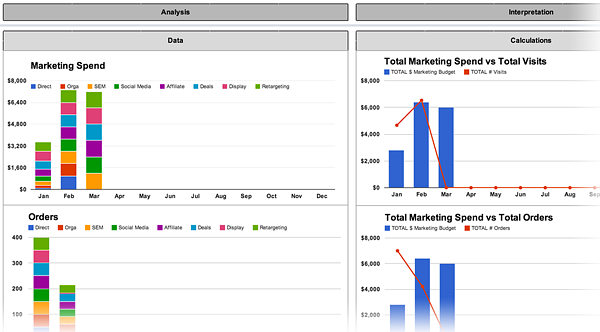
As an investor, I do not care if the profit margin per channel is optimized by 3% in the first 1-2 years of a company already. As a matter of fact, I would question if the entrepreneur is focussing on the right things. I want to see that the company has found channels that it can grow through quickly. If I pour in more money. Yet, in a somehow profitable way. You see, having the holistic view matters.
Just like Christoph Janz suggests with his SaaS KPI Tracking Sheet, or at a later stage Geckoboard, Leftronic, Boarrd or Tableau: The most important thing is, that you start tracking what you are doing. And then base your decisions on data.
And there are easy and understandable explanations for that. It’s time consuming, it’s cumbersome, and often you don’t know where to start. Yet, almost everyone agrees that it is necessary to draw the right conclusions and to steer your marketing ship into the right direction.
Here is an initial Marketing KPI Tracking tool to compare your marketing channels – modeled for an e-commerce business. You can, actually you should, adapt it to your needs, business model, and status of your company. However, you should start tracking your activities as early as possible.
The dashboard is setup in google docs, you can also download it and use it in excel. Yet, I strongly suggest that all influencing team members have a clear view on your companies KPIs at all time. I therefore recommend using a google doc version. As a matter of fact, I recommend making people responsible to add the data for their work streams / marketing channels themselves. This way you make sure everyone is always up to date with the relevant key performance indicators that he/she is responsible for. Nevertheless, these KPIs are sensitive data. Make sure to withdraw access if your employees move on or leave your company. ** UPDATE ** As Marc from Jakarta just told me, the Excel download does not seem to work right now. I will be publishing a dedicated offline version soon. ** UPDATE **
The most important KPIs
The google spreadsheet is a basic tracker. It is limited to most high level KPIs, broken down per Marketing Channel. It is a start to your more advanced and adjusted KPI tracking dashboard. You will need to adjust it to your company / business model / industry. However, it should demonstrate how you can organize the information and make sure you track them.The sheet tracks the following KPIs, broken down per channel and over time:
- Marketing Spend: How much money did you spend on activities allocated to this channel.
- Visitors to the website: How many visitors did you attract through this channel.
- Orders: How many orders did you generate via this channel.
- Orders / Customer: How many orders does a customer submit, who was first attracted through this channel. This KPI is influenced by other factors as well, but gives you an initial feeling for the customer quality. It is up to you how you define “lifetime” (1m/6m/1y). In a later version I will go into CLV management more deeply.
- Revenue: How much revenue did you generate through sales, that came form this channel.
- Discounts: How many discounts did you have to pay for orders, generated through this channel.
What we can do with these KPIs
In addition, the tracker calculates the following KPIs:- Basket Size (Basket): How much revenue did this channel generate per order. It helps you to understand the economic value of the customers that you attract through the different marketing channels.
- Conversion Rate (CR): How many customers per 100 visitors, that came to your site, finally ordered a product? The Conversion Rate helps you to understand if people that came through this channel only browsed around, or actually purchased something.
- Cost Per Order (CPO): How efficient is this marketing channel? The cost per order tells you how much you spent to generate one order.
- Real Cost Per Order (real CPO): To be able to compare channels on a CPO basis (which channels generates the cheapest customers), the CPO should be adjusted by certain factors. One big influencer is the discounts you needed to give to generate an order. E.g. flash sales are usually relatively cheap to initiate, however you need to give huge discounts. This increases the adjusted (real) CPO accordingly.
- Customer Lifetime Value (CLV): How much revenue does a customer that is generated through this channel generate for you. This factors in the average basket size, as customers that come through different channels reorder differently, and spend different ammounts.
- Return On Marketing Investment Factor (ROMI Factor): How much revenue did you generate per dollar invest? It helps you to understand the return per marketing channel. It is already adjusted with discounts to compare the factor cross channel. If you want you can adjust the factor by other influencers.
One could argue, that optimizing for profit margin and comparing channels on a contribution margin basis would solve this issue. However, the counter argument begins with: It depends. It depends on what your goal is. If your only goal is to raise the bottom line, comparing channels by a profit margin / contribution margin view is ultimately correct. In my opinion. Yet, can you scale the most profitable channel indefinitely? How much time do you spend on these most profitable channels? Furthermore, many companies, especially in the early stage, look for more than just margins. They want to to grow. Grow in orders / customers / basket sizes to then show improvements to raise the next round of money. Therefore it seems logical to track and compare more than just the bottom line. However, this discussion will be subject for a post of its own.
As an investor, I do not care if the profit margin per channel is optimized by 3% in the first 1-2 years of a company already. As a matter of fact, I would question if the entrepreneur is focussing on the right things. I want to see that the company has found channels that it can grow through quickly. If I pour in more money. Yet, in a somehow profitable way. You see, having the holistic view matters.
Limitations and things to understand when tracking KPIs
To draw the right conclusions, you need to know the following two measuring limitations. These should be fixed at one point to increase your interpretation accuracy.- Multi-Channel Attribution Modeling: In today’s educated customer world, consumers will most likely come across your offering multiple times before making a purchasing decision. Tracking contact paths shows, that many customers have multiple touch-points with you, before they purchase.
Therefore: When you attribute a sale to a channel, which one do you consider? The one with the biggest budget? The one that you like best? The first one that a customer came across, because that is how he learned about you? The one that he visited last? This KPI sheet here leaves this open. In the beginning I suggest the Last Interaction / Click Attribution / Origin Attribution model. Or simply: What was the last touchpoint the users had and attribute the sale to this channel. This is wrong. yet the issue lies in the measuring part of your business intelligence. And in your philosophy. Avinash Kaushik has written a very detailed article about Multi-Channel Attribution Modeling. He explains how to better attribute a sale to a channel. In short: He, and many more advanced companies, (and you should consider it relatively soon, too) distribute the sale with changing weights to the different marketing channels a customer has had touch-points with, before he/she placed the order. Not only the last one. - Time Lag: Some marketing channels will generate costs in one month, but generate orders in the next. That might improve or degrade channels rating artificially. Keep that in mind during interpretation of the KPIs, or adjust the data when measuring it.
Furthermore: When you analyze KPIs like Orders per Customer, you will today track past influencers on the KPI. Yet, this is the case for all KPIs.
Just like Christoph Janz suggests with his SaaS KPI Tracking Sheet, or at a later stage Geckoboard, Leftronic, Boarrd or Tableau: The most important thing is, that you start tracking what you are doing. And then base your decisions on data.
Data driven management – why E-Commerce KPIs matter
Most of my management experience comes form e-commerce related companies. Yet at Earlybird Venture Capital, we hardly ever invest in e-commerce models. An issue? Not really. Having worked in a mainly data driven environment, I strongly believe that most of my experience of running companies with a focus on the principles of to measure, to track and to adapt can be applied to any company. Actually, it should be applied. The more you measure and track the more you understand relations between actions and reactions within your company and from outside.
Being able to measure KPIs is what makes todays businesses so great. Especially in an online world, measuring and tracking has become so easy. With free tracking tools anyone can start building his own KPI dashboard. I want to give a starting point from where you can build your own tools. Change it, adapt it, use it. Call it your own. Yet if you like it, I would love to read about it in the comments.
In the coming months I want to introduce a number of data based management tools that should help you run your early state e-commerce company. Again, why commerce? I think many things can be adopted from the e-commerce world easily. If I introduce a tool that measures reoccurring SaaS revenue and COGs for a software product, it might be more difficult to adapt this to your e-commerce business, than the other way round. E-commerce businesses only work if you understand your KPIs. Or unit economics as we like to call it. The competition is fierce and if you don’t understand your own success or failure, you can adapt quickly and improve quickly. In the end, you need to become a Business Intelligence master, at least on the interpretation side of if, to guarantee the success of your startup.
My first tool will be a marketing KPI tracker on google docs, looking forward to your comments.
Being able to measure KPIs is what makes todays businesses so great. Especially in an online world, measuring and tracking has become so easy. With free tracking tools anyone can start building his own KPI dashboard. I want to give a starting point from where you can build your own tools. Change it, adapt it, use it. Call it your own. Yet if you like it, I would love to read about it in the comments.
In the coming months I want to introduce a number of data based management tools that should help you run your early state e-commerce company. Again, why commerce? I think many things can be adopted from the e-commerce world easily. If I introduce a tool that measures reoccurring SaaS revenue and COGs for a software product, it might be more difficult to adapt this to your e-commerce business, than the other way round. E-commerce businesses only work if you understand your KPIs. Or unit economics as we like to call it. The competition is fierce and if you don’t understand your own success or failure, you can adapt quickly and improve quickly. In the end, you need to become a Business Intelligence master, at least on the interpretation side of if, to guarantee the success of your startup.
My first tool will be a marketing KPI tracker on google docs, looking forward to your comments.
Leaving New York – moving to Berlin
Leaving New York City was not as easy as I thought. I loved the 24/7 availability of food, transportation, action, brands, intensity. Time does not matter. You can get anything you want, at any time you need it. Ethiopean rice dish? On Bleeker Street. Swiss Cheese Fondue? Swizz on 53rd. The best Pastrami Sandwich you will find? Katz on Houston. Sundays? What are Sundays.
I lived in Berlin in 2007 – and I hated it. What is hip about unfriendly people? Why would you be ok with a broken subway system? Yes, I prefer if the trash system works. I hated it.
However, Berlin was changing. From super fucked up to only half fucked up. I visited the city at least a couple of times a year. It was actually adapting to what I liked about New York City, especially about the Upper West and the Lower East Side: Artisan cheese shops, independently owned paper stores, little bakeries and galleries. The things you visit on Saturday morning. Or when you leave the office on the way home. And I saw my friends moving into apartments, that would cost me double my salary in New York. Or as a matter of fact in any other city that I lived in so far.
So when it came down to the decision of where to move next, I had the choice between my favorite German city Munich, and this ever changing beast, Berlin. Still dirty, still ugly, yet the rents still somehow cheap. A tough one, yet I went with Berlin.
Now after three months in the city, I could not be more happy. Friday’s hipster farmers markets on Arkonaplatz. Sundays hipster brunch on Auguststr. Weekdays hipster coffees at Kaffeemitte. Ok, everything pretty hipster. But I somehow like it. And there are somehow fewer people yelling at me because of nothing. The weather still sucks. But so does the weather in Stockholm and London.
So though I obviously miss New York City, I am happy I moved to Berlin next. Even more happy I signed as a VC. And that is what this blog will be all about. Cheers.





I lived in Berlin in 2007 – and I hated it. What is hip about unfriendly people? Why would you be ok with a broken subway system? Yes, I prefer if the trash system works. I hated it.
However, Berlin was changing. From super fucked up to only half fucked up. I visited the city at least a couple of times a year. It was actually adapting to what I liked about New York City, especially about the Upper West and the Lower East Side: Artisan cheese shops, independently owned paper stores, little bakeries and galleries. The things you visit on Saturday morning. Or when you leave the office on the way home. And I saw my friends moving into apartments, that would cost me double my salary in New York. Or as a matter of fact in any other city that I lived in so far.
So when it came down to the decision of where to move next, I had the choice between my favorite German city Munich, and this ever changing beast, Berlin. Still dirty, still ugly, yet the rents still somehow cheap. A tough one, yet I went with Berlin.
Now after three months in the city, I could not be more happy. Friday’s hipster farmers markets on Arkonaplatz. Sundays hipster brunch on Auguststr. Weekdays hipster coffees at Kaffeemitte. Ok, everything pretty hipster. But I somehow like it. And there are somehow fewer people yelling at me because of nothing. The weather still sucks. But so does the weather in Stockholm and London.
So though I obviously miss New York City, I am happy I moved to Berlin next. Even more happy I signed as a VC. And that is what this blog will be all about. Cheers.








